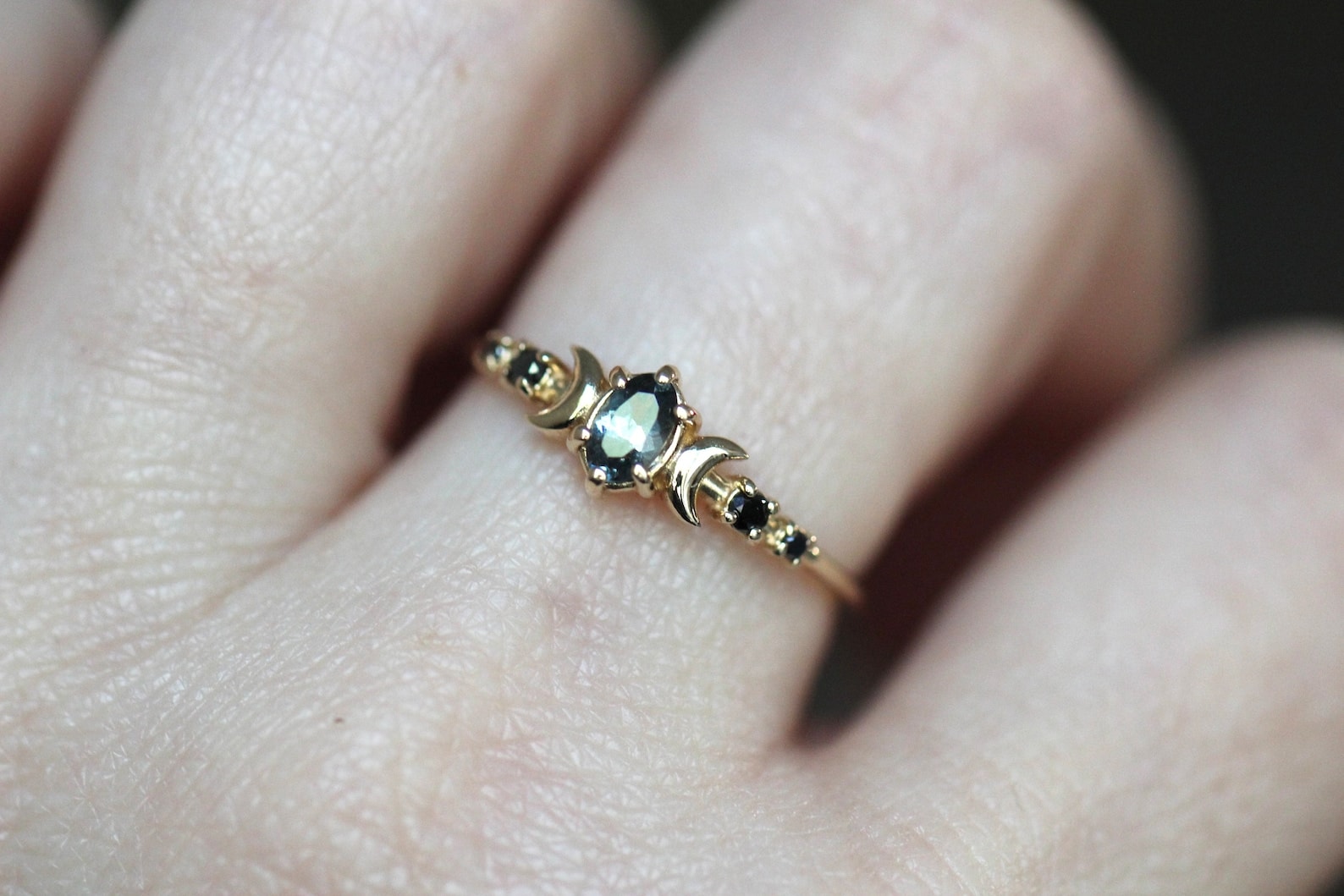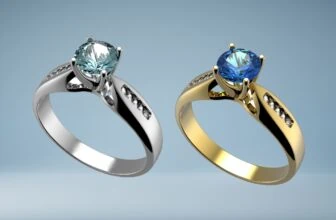
Table of Contents
Spinel, a lesser-known yet stunning gemstone, is making waves in the jewelry world. Known for its wide range of vibrant colors and impressive durability, it’s becoming a top pick for both gem lovers and jewelry designers. This gemstone isn’t just beautiful; it also boasts an intriguing history, often mistaken for rubies and sapphires in historical royal crowns.
Let’s explore the fascinating aspects of spinel, including its unique qualities, diverse color options, and why it should be part of your jewelry collection.
What is Spinel?

Spinel, a beautiful gemstone, is famous for its stunning color range and brightness. The name “spinel” might come from the Latin “spina” for its pointed crystal shape, or the Greek “spinther,” meaning sparkling. Its array of colors, including deep reds, bright pinks, blues, purples, and black, stands out. The red spinels, often confused with rubies in the past, are the most well-known.
Spinel is made of magnesium aluminum oxide and is quite hard, scoring an 8 on the Mohs scale. This hardness makes it durable for all kinds of jewelry. The crystals usually have an octahedral shape. Spinel is also known for its clearness and shiny luster, adding to its sparkle.
High-quality spinels, especially large ones without inclusions, are rare and very sought after in the gem market. Its unique beauty and rarity make spinel a popular choice among gem lovers and those who collect jewelry.
Origin and History

For centuries, spinel has shared its history with many famous gems and cultures. People often confused it with ruby because they look similar. This mix-up led to spinel appearing in many important historical jewels. For example, the famous “Black Prince’s Ruby” and the “Timur Ruby” in the British Crown Jewels are actually large red spinels.
You can find spinel in many places around the world, including Sri Lanka, Myanmar (Burma), Vietnam, Tajikistan, and Afghanistan. The Badakhshan mines in Afghanistan have been known for producing excellent spinels since around 750 AD, making the stone historically significant.
In the past, people loved spinel for its beauty and thought it protected its owner. Kings and emperors often wore it in their crowns and jewelry. However, spinel was not widely known to most people until more recently.
In the twentieth century, as the science of gems improved, spinel became more popular. Better understanding and identification of gemstones helped spinel gain recognition for its unique qualities and various colors. Now, people admire spinel for its natural beauty, and it’s a popular choice among collectors and those who love jewelry.
How to Evaluate Spinel
Like many gemstones, the value of spinel can be measured through its cut, color, clarity, and carat.
1. Color

Spinel comes in a variety of hues, including black, blue, pastels, pink, orange, and brown. However, the most popular and valued colors are red, pink, and orange. Red spinel looks strikingly similar to rubies. Interestingly, red spinel is much rarer than rubies, but due to its extreme rarity there is little demand for it and therefore it is not as valuable.
As with any gemstone, spinel with even saturation and intense hue are the most valuable.
2. Clarity
Spinel with fewer inclusions is more valuable than those with a high amount of impurities. Generally, spinel has high clarity levels and most stones are eye-clean. Some spinel gemstones have very distinct and beautiful inclusions.
Sometimes spinel can contain inclusions of long thin wispy cracks. When cut in cabochon, these impurities can create a star-like effect on the surface of the stone, known as asterism. These are rare and very beautiful.
3. Cut
Spinel can be cut into a range of shapes and styles, such as round, oval, cushion, and pear. The best way to cut a spinel is by faceting. Because spinel has a high refractive index and dispersion, it is a brilliant and fiery stone. Expert cutting will emphasize these factors and maximize the beauty of the stone.
Because spinel is very rare, most cutters choose the cut and size in order to use as much of the rough as possible. This is why many spinel stones on the market are not cut to standard sizes.
4. Carat Size

Spinel gemstones come in a wide range of carat sizes. You can find them as small accent stones under a carat or as large, eye-catching stones of several carats. The choice of spinel size often depends on the jewelry type and personal taste. For instance, rings or pendants might feature larger spinels, while earrings or accent stones are generally smaller.
It’s worth noting that spinel, though less famous than some gems, can be quite valuable. Larger spinels with good clarity and color, especially rare hues like cobalt blue, vibrant pink, or deep red, are more valuable. Spinel stones over one carat are particularly prized and expensive. Like all gems, the rarity of large, high-quality spinel increases its value.
Is Spinel Valuable?

Spinel, a gemstone that often gets less attention than rubies and sapphires, is becoming more recognized and valuable in the gem market. Its wide range of colors, including deep reds and vibrant blues, along with its clearness and durability, make it a popular choice for jewelry.
Historically, people often confused spinel with ruby. In fact, some famous “rubies” in royal crowns are actually spinels. The value of spinel depends on its color, clarity, size, and cut. The most valuable spinels are red and vivid pink, especially those that are clear and without inclusions.
Although synthetic spinels have impacted the market, natural, high-quality spinels still hold great value. Collectors and gem enthusiasts particularly treasure these spinels for their unique beauty and historical importance.
Imitations and Synthetic Spinel

Both imitation and synthetic spinel gemstones are available. Laboratories create synthetic spinel to look and act like natural spinel. They use methods like flame fusion or the Czochralski process. These lab-made spinels have the same chemical makeup and physical traits as natural spinel and are a more affordable choice in jewelry.
Imitation spinel, however, is different. Materials like glass or cubic zirconia only look like spinel but don’t share its chemical or physical properties. These imitations copy the color and appearance of spinel.
Although synthetic and imitation spinels are less expensive, they usually don’t have the unique features and rarity of natural spinel. Because of this, natural spinel is still very sought after in the gem market for its authenticity and natural beauty, especially by collectors and those who love gems.
Red Spinel vs. Ruby
Red spinel and ruby, both known for their deep red color, have unique features. In the past, people often confused them, with many famous royal “rubies” actually being red spinels. Rubies are a type of corundum, mainly made of aluminum oxide with chromium, which gives them their red color.
Spinel, on the other hand, is made of magnesium aluminum oxide. This difference in composition means rubies are a bit harder than spinels. Color-wise, both gems can have a vibrant red, but rubies usually shine more brightly under certain lights because of their fluorescence.
Natural rubies often have inclusions or “silk,” unlike the typically clearer spinels. In the gem market, rubies usually cost more due to their rarity and historical importance. But red spinels, known for their beauty and rarity, are becoming more popular and are valued by collectors and gem lovers.
Spinel Jewelry Types
Spinel is a good choice for jewelry because it holds up well to rough wear. Most spinel jewelry on the market is small and dainty; it is difficult to find large statement pieces made of natural spinel.
1. Earrings

Spinel earrings offer sophistication and versatility, with designs ranging from small studs to dramatic drops or chandeliers. The wide color range of spinel means these earrings can match any outfit or occasion.
Classic styles include simple black or deep blue spinel studs for a subtle elegance, while brighter red or pink spinels in drop earrings add a vivid touch of color. Designers often mix spinels with diamonds or other gems in intricate designs, creating modern, timeless pieces. Spinel’s durability also makes it a great choice for earrings, ensuring they stay beautiful with regular wear.
2. Rings

Spinel rings stand out for their color variety, including deep reds, pinks, blues, purples, and blacks. These rings usually put the spinel in the spotlight, sometimes paired with diamonds or other gemstones to highlight its beauty.
Red and pink spinel rings are especially popular, often set in rose or white gold to match their warm colors. These rings suit everyday wear and special events, thanks to their durability. They come in many designs, from simple solitaires to elaborate, vintage-inspired styles.
3. Pendants and Necklaces

Spinel necklaces and pendants showcase the gem’s brilliance and color range. A single, brightly colored spinel, like cobalt blue or fiery red, often forms a striking pendant, set simply to emphasize its beauty.
These necklaces vary from delicate, elegant pieces for daily wear to bold, statement pieces for formal occasions. Designers sometimes blend spinels with other gems in necklaces, creating eye-catching color mixes and patterns that enhance the luxury of the piece.
How to Take Care of Spinel

To keep spinel and its jewelry in good condition, follow these simple steps. Protect spinel from hard hits and scratches. When you’re not wearing it, store it in a soft pouch or a jewelry box with lining to avoid scratches.
Clean your spinel jewelry regularly to keep it shining. At home, you can use warm water and mild soap for cleaning. Gently brush the stone and its setting with a soft toothbrush. Be careful with delicate settings to prevent the stone from coming loose. After scrubbing, rinse the jewelry well to get rid of soap and dry it with a soft, lint-free cloth. Don’t use strong chemicals or ultrasonic cleaners; they could harm the stone.
Take off spinel jewelry during activities like sports or gardening to avoid accidental damage. Also, keep it away from extreme or rapidly changing temperatures, which could damage the stone.
It’s a good idea to have a professional jeweler check the jewelry regularly, especially if you wear it often. This check helps ensure the settings are tight and can stop the stone from getting lost, helping your jewelry last longer.
What Does Spinel Symbolize?

Spinel, a gemstone known for its history and vibrant colors, symbolizes several things. It often represents energy and renewal, believed to help with healing and rejuvenation. Its wide color range, including bright reds and deep blues, adds to its symbolism.
Red spinel, for example, links to vitality and passion, similar to how rubies historically symbolize love and energy. Blue spinel connects to calmness and spiritual renewal. Beyond its colors, spinel stands for hope and optimism, providing support in tough times.
In some cultures, people believe spinel can bring wealth and prosperity and help achieve goals. It’s also valued for its protective qualities, with some wearing it as a talisman to keep away negativity and focus more on spiritual matters than material ones.
Where to Buy Spinel Jewelry
- When you buy spinel jewelry from Etsy, you enter a world of unique, often handmade pieces from individual makers and small shops. It’s key to check the seller’s ratings and read the descriptions well. Many Etsy sellers offer to customize jewelry, making it great for personalized items.
- On Amazon, you find a broader selection of spinel jewelry, from budget-friendly to high-end. Pay attention to the brand’s reputation and customer reviews to judge the jewelry’s quality. Amazon makes it easy to compare prices and qualities and usually has a trustworthy return policy.
Wrapping Up
Spinel, a gemstone with a stunning range of colors, durability, and a rich history, deserves more recognition. It shines in elegant jewelry and as a collector’s gem, offering beauty and variety. Its increasing popularity and distinct features make it a great choice for any collection or style. The diverse and captivating world of spinel welcomes gem lovers and casual fans alike to explore its charm.









